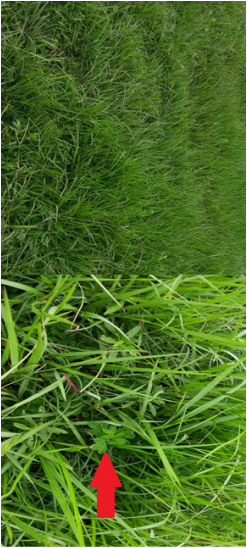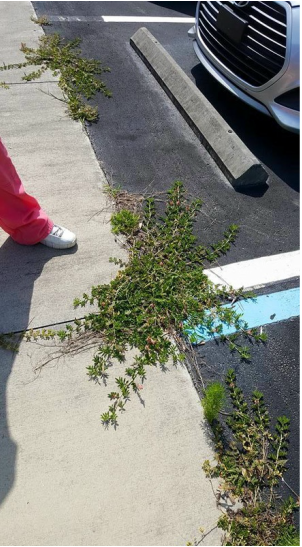how do You kill it ? :
This weed is very persistent and CAN and WILL grow ANYWHERE that is sub-tropical in climate. Lush pastures, sandy beaches, concrete jungles and marshy wetlands- can all house this dangerous weed.
Therefore, adopting a diligent pasture management program with the proper herbicide is very important in helping you ward off this predator plant. Creeping Indigo is rooted VERY FIRMLY in the soil, making it PARTICULARLY difficult to manually remove. So, the most effective plan of attack for this particular weed is to treat it with the proper herbicide.
Therefore, adopting a diligent pasture management program with the proper herbicide is very important in helping you ward off this predator plant. Creeping Indigo is rooted VERY FIRMLY in the soil, making it PARTICULARLY difficult to manually remove. So, the most effective plan of attack for this particular weed is to treat it with the proper herbicide.
HOW TO TREAT:
MANY herbicides/products can kill Creeping Indigo, but only TEMPORARILY. This is because DEEPLY ROOTED weeds (such as CI) require an herbicide capable of a SLOW KILL. A weed with a deep root will sprout back when treated TOO HARSHLY. This is because the leaves are burned by the product and the plant actually shuts down to protect itself before thoroughly absorbing the herbicide all the way to the tip of it's deep root- which means, you'll have new growth from the weed within a couple weeks. This is why things such as vinegar/vinegar based products and other harsh treatments including overly concentrated herbicides are not effective on this weed. The ideal "turn time" for a deeply rooted weed is 4-7 days minimum.
The following list of herbicides have been proven to kill Creeping Indigo permanently:
Grazonext HL: BROADCAST application rate: 24oz per acre // SPOT TREATMENT application rate: 0.5oz per gal *** should not be applied to St Augustine grass pastures as severe forage injury will occur.
Banvel: BROADCAST application rate: 32oz per acre *spot spraying 0.6oz per gal, ***Volatile- use caution with sensitive plants.
Remedy Ultra: BROADCAST application rate: 16-32 oz per acre // SPOT TREATMENT application rate: .5oz per gal *** Volatile- use caution with sensitive plants.
2,4-D Amine: BROADCAST application rate: 64oz per acre // SPOT TREATMENT application rate: 1oz per gal *** Volatile- use caution with sensitive plants.
Dicamba: BROADCAST application rate: 32oz per acre BROADCAST // SPOT TREATMENT application rate: 5oz per gal
Pasturegard HL: BROADCAST application rate: 16oz per acre // SPOT TREATMENT application rate: .5oz per acre
Metsulfuron 3: BROADCAST application rate: .3oz per acre // SPOT TREATMENT application rate: .001oz per acre *** should not be applied to bahiagrass pastures as severe forage injury will occur.
*** Be sure to read and follow the specific herbicide label for further risks or detail.
*** Manure from animals grazing pastures treated with this herbicide should not be
composted, but can be spread back onto the treated pasture.
The following list of herbicides have been proven to kill Creeping Indigo permanently:
Grazonext HL: BROADCAST application rate: 24oz per acre // SPOT TREATMENT application rate: 0.5oz per gal *** should not be applied to St Augustine grass pastures as severe forage injury will occur.
Banvel: BROADCAST application rate: 32oz per acre *spot spraying 0.6oz per gal, ***Volatile- use caution with sensitive plants.
Remedy Ultra: BROADCAST application rate: 16-32 oz per acre // SPOT TREATMENT application rate: .5oz per gal *** Volatile- use caution with sensitive plants.
2,4-D Amine: BROADCAST application rate: 64oz per acre // SPOT TREATMENT application rate: 1oz per gal *** Volatile- use caution with sensitive plants.
Dicamba: BROADCAST application rate: 32oz per acre BROADCAST // SPOT TREATMENT application rate: 5oz per gal
Pasturegard HL: BROADCAST application rate: 16oz per acre // SPOT TREATMENT application rate: .5oz per acre
Metsulfuron 3: BROADCAST application rate: .3oz per acre // SPOT TREATMENT application rate: .001oz per acre *** should not be applied to bahiagrass pastures as severe forage injury will occur.
*** Be sure to read and follow the specific herbicide label for further risks or detail.
*** Manure from animals grazing pastures treated with this herbicide should not be
composted, but can be spread back onto the treated pasture.
WHEN TO TREAT:
Weeds shut down when stressed and when they are shut down- they do not drink applied herbicides. Stress can be caused by drought, cold snap, mowing and treatment. You want to treat the weed right about the same time you think you need to mow. (when the grass is about 6in) For best results; treat during Spring-Summer rain seasons when the plant is active and thriving.
WHEN TO TURN OUT:
We suggest that, even though, you can safely graze your animals on the herbicides that we list here to kill CI, that you still wait to turn out until the weed has reached a crumbled/dry state. At this point, animals can no longer pick it up and eat it. (10-14 days) Our concern is not the herbicide but, the weed itself.
This is because: herbicides often temporarily raise the sugar level in weeds and making even the bitter noxious weeds, more palatable. Creeping Indigo, in particular, is very palatable already and is also suspected to spike in toxicity when stressed. This is why we believe withholding turn out to be the BEST PRACTICE for the safety of your animals. .
YES- this means no turn out for 10-14 days. But, it is worth it! Your animals will only be unhappy temporarily and they will be ALIVE AND WELL in their future!
For more information on the affects of herbicides on sugar content of weeds... see:
This is because: herbicides often temporarily raise the sugar level in weeds and making even the bitter noxious weeds, more palatable. Creeping Indigo, in particular, is very palatable already and is also suspected to spike in toxicity when stressed. This is why we believe withholding turn out to be the BEST PRACTICE for the safety of your animals. .
YES- this means no turn out for 10-14 days. But, it is worth it! Your animals will only be unhappy temporarily and they will be ALIVE AND WELL in their future!
For more information on the affects of herbicides on sugar content of weeds... see:
HOW TO HELP PREVENT:
Creeping Indigo has a VERY quick rate of travel. Dr Julia Morton's studies concluded that ONE plant could over take a pasture in a short 6 months!!! (Yikes) Adopting these practices along with yearly treatment for legume killing herbicides should keep this weed from over taking your land before your next herbicide treatment:
Treating and re-seeding your pastures every year, rotating your pastures and supplementing hay in the Winter is common knowledge for the average horse owner. Creeping Indigo is more reason to keep it up! Dense grass can SLOW the spread of Creeping Indigo down and keep it more manageable if it is spread back to your land between treatment intervals.
UF suggests the following guidelines for healthy pastures:
1 acre of grazing for every 600-700lbs of horse on your land. If you cannot meet this requirement- rotate your pastures/stall time to allow the pasture to rest. They suggest keeping your grass between 3-6" in length and remove your animals when the grass reaches 3" to allow the grass to recover and remain dense. You may also supplement hay throughout the year if your acreage per horse is on the low-end. But, they suggest ever owner at least supplement hay in the Winter months.
You may also manage your soil's PH levels. Creeping Indigo does not thrive below 4.5 or above 6.5 and therefore, will not spread as quickly.
Treating and re-seeding your pastures every year, rotating your pastures and supplementing hay in the Winter is common knowledge for the average horse owner. Creeping Indigo is more reason to keep it up! Dense grass can SLOW the spread of Creeping Indigo down and keep it more manageable if it is spread back to your land between treatment intervals.
UF suggests the following guidelines for healthy pastures:
1 acre of grazing for every 600-700lbs of horse on your land. If you cannot meet this requirement- rotate your pastures/stall time to allow the pasture to rest. They suggest keeping your grass between 3-6" in length and remove your animals when the grass reaches 3" to allow the grass to recover and remain dense. You may also supplement hay throughout the year if your acreage per horse is on the low-end. But, they suggest ever owner at least supplement hay in the Winter months.
You may also manage your soil's PH levels. Creeping Indigo does not thrive below 4.5 or above 6.5 and therefore, will not spread as quickly.


